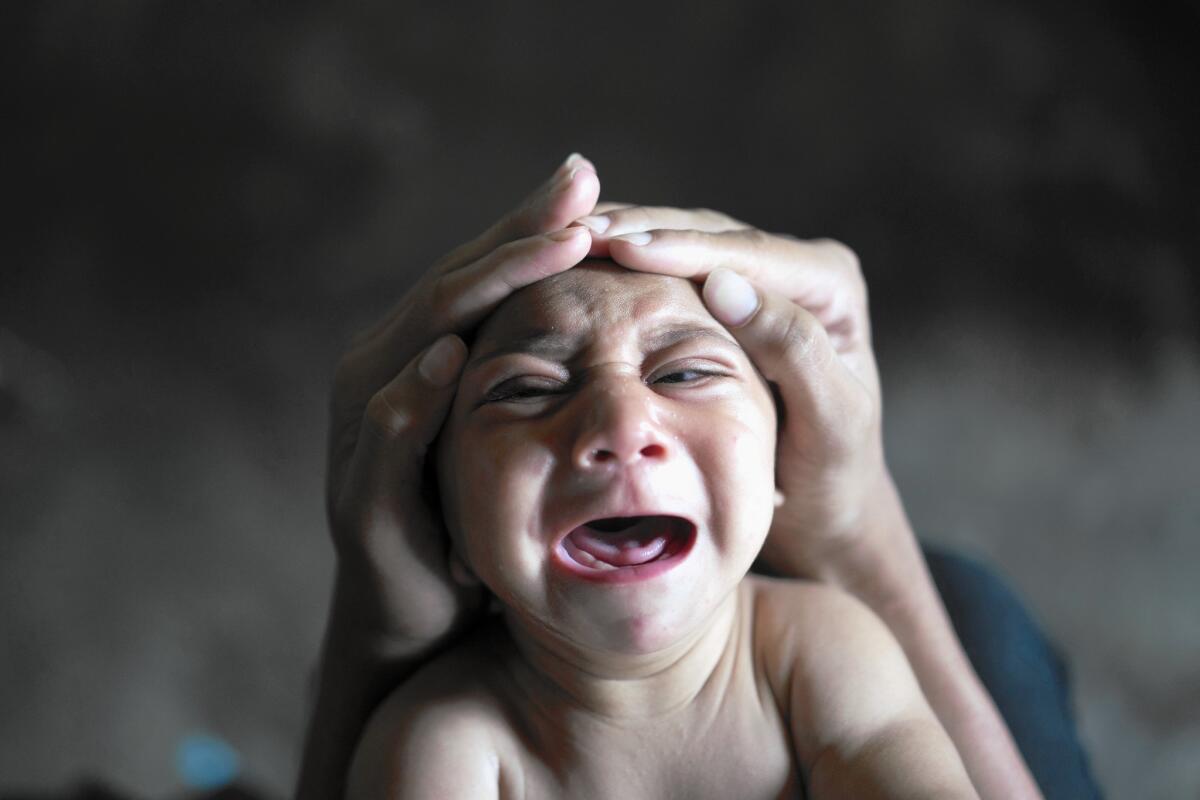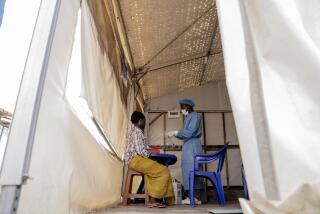Op-Ed: Zika outbreak bears an eerie resemblance to the spread of Ebola

A baby boy is attended to in Bonito, Brazil on Jan. 30. The child was born with microcephaly, and screams uncontrollably for long stretches.
- Share via
The Zika virus headlines may seem disturbingly familiar — with good reason. Although Zika and Ebola are very different contagions that cause distinctive diseases, there are startling similarities in how the two epidemics unfolded.
Both were detected late. By the time health authorities understood that we were in the midst of an Ebola outbreak, the virus had been spreading for months and across multiple international borders. We are only now starting to piece together the magnitude of the Zika crisis, but the more than 20-fold surge in reports of microcephaly — a neurologic birth defect believed to be caused by Zika infection in pregnant women — last year in Brazil suggests that extensive viral spread in late 2014 and early 2015 went unnoticed.
These patterns--slow detection, sluggish response, and endangered vulnerable populations--will repeat themselves until we fix the forces driving them.
Both disease outbreaks generated sluggish international responses. The World Health Organization was lambasted for its long delay before labeling the Ebola outbreak an international emergency. With Zika cases now reported in 23 countries and territories in the Americas and up to 1.3 million infections in Brazil alone, WHO finally declared the outbreak an international public health emergency on Feb. 1. It remains to be seen whether WHO will effectively escalate international control and research efforts, while preventing countries from imposing unwarranted travel and trade restrictions.
And in both outbreaks, the heaviest burden fell on vulnerable populations least able to bear it. Ebola swept across three post-conflict countries that are among the world’s poorest and lowest-ranked in terms of human development. Brazil’s outbreak of microcephaly was centered in the north — one of its poorest areas.
These patterns — slow detection, sluggish response and endangered vulnerable populations — will repeat themselves until we fix the forces driving them.
A post-Ebola report released by the National Academy of Medicine last month estimated that pandemics cost the global economy on average over $60 billion each year, and it prescribed an annual global investment of $4.5 billion, mostly to bolster public health systems. It recommended that WHO disseminate a daily “watch list” of outbreaks and streamline its emergency preparedness and response activities into one reliably funded and separately governed center. Finally, the report suggested funding a pandemic research group that would be supported by but independent of WHO, and that would build surge capacity for drugs needed in health emergencies.
To build an effective global system for containing infectious diseases like Zika and Ebola, we need to make sure that countries around the world have the surveillance capacity to identify outbreaks before they spiral out of control. That means giving technical and financial assistance to developing countries and having external monitoring and incentives to make sure that capacity is built. We also need to make sure that WHO — the only organization with the representation and legitimacy to do so — is up to the task of leading outbreak response when local forces are overwhelmed.
Not only do we know how to create a functioning global system, doing so is actually required under international law.
The 2005 International Health Regulations, introduced by WHO and binding on virtually every country in the world, set standards for how to track, report and respond to outbreaks. Countries were supposed to build the capacity needed to meet these standards by 2012, with possible extensions to 2014 and 2016. Time is quickly running out, yet only a third of countries worldwide said they had complied as of late 2014. The real compliance rate is almost certainly lower.
Now that Zika is at the forefront of international attention, let’s remember the broader systemic shortcomings that got us here in the first place.
Without serious investment in global health systems, we will continue to face pandemics like Ebola and Zika and their devastating consequences.
Yanbai Andrea Wang is a fellow at the Center for Law and the Biosciences at Stanford Law School. Michele Barry is director of the Center for Innovation in Global Health at Stanford School of Medicine.
Follow the Opinion section on Twitter @latimesopinion and Facebook
More to Read
Sign up for Essential California
The most important California stories and recommendations in your inbox every morning.
You may occasionally receive promotional content from the Los Angeles Times.










